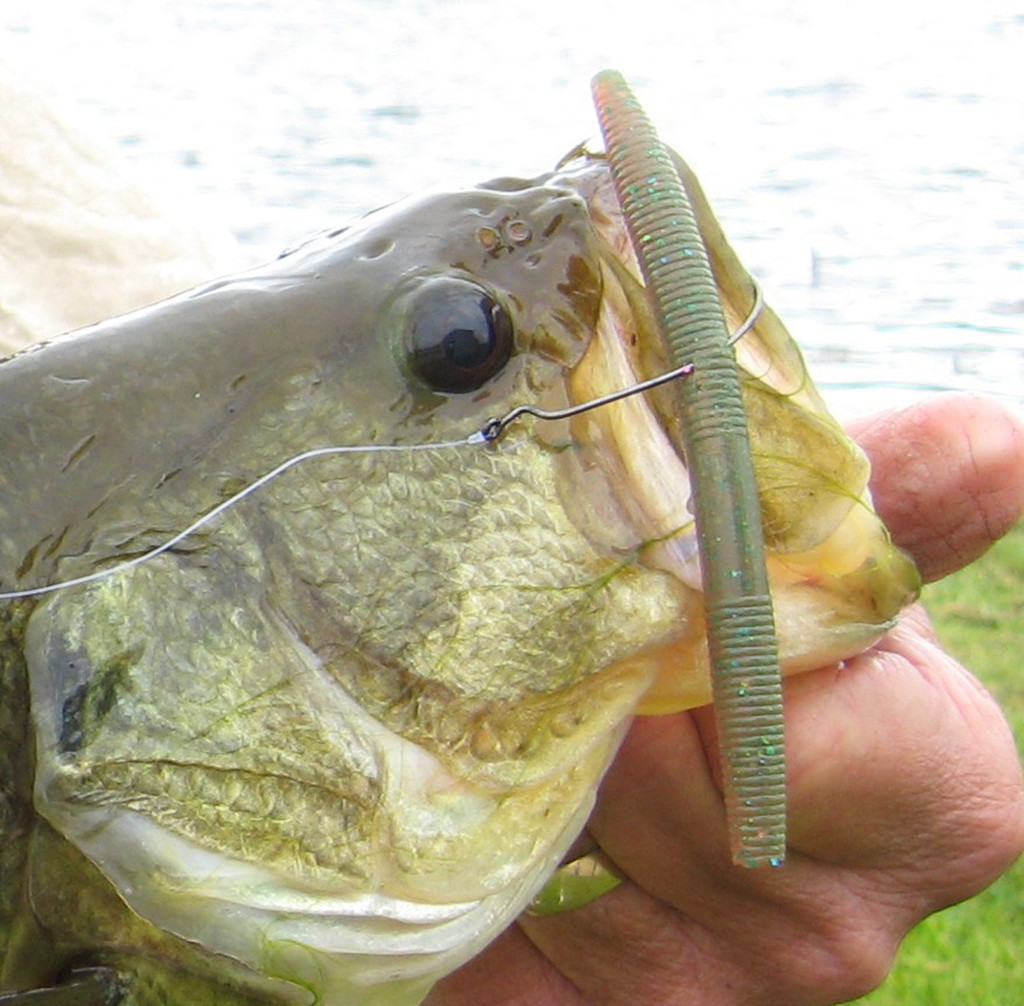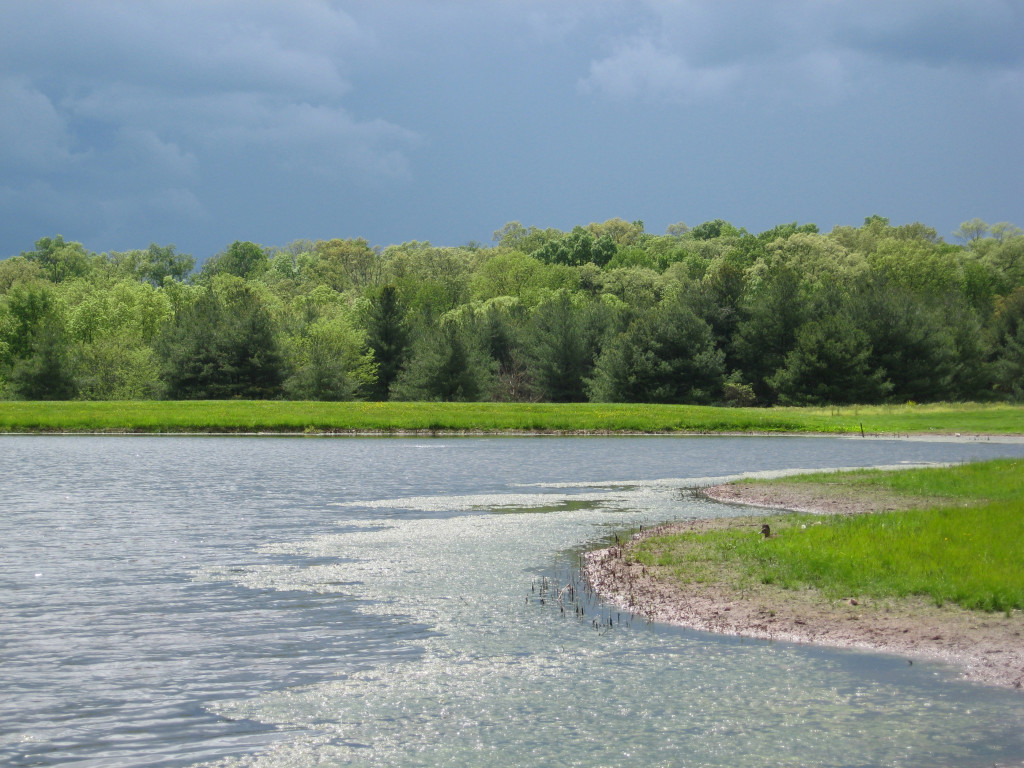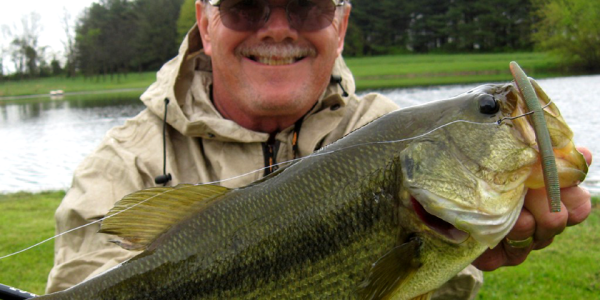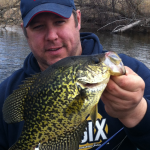By Jim Gronaw
Bass fishing has been very good to us the past spring seasons of 2014 and 2015. After what seemed like an eternity for some warm weather, we finally got a break around mid April, both years, and the weather then stabilized, keeping water temps in the 60 degree range. This quickly pushed bass up in shallow in preparation for the spawn, but the influx of cold fronts kept temperatures stable, prolonging the pre-spawn bite for larger females. We found that on the nastiest, rainiest and windy days, fish were most active and aggressive. We only picked up a few good fish when the sun came out and it got calm.

With bass being shallow and relatively few obstructions to deal with, we found that we could fish lighter than usual line and enjoy excellent sport on fish from three to almost six pounds. We used six foot light action spinning sticks with Sufix Clear Mono in 6 and 8 pound test to fish our favorite stick worms…the Stank X Stix…as bass would cruise shallow flats in anticipation of the upcoming spawn. In a network of a dozen ponds and quarries, we totaled 646 largemouths in spring of 2014 and 2015, with nearly 250 fish in excess of three pounds. No, not the numbers from the tournament guys on the pro circuit, but fish I am certainly happy to catch when bassing close to home, blue collar style.
As most bass anglers are aware, braid and heavy mono rule the roost in line choice, even when the fish are only a pound and a half. Wood, weeds and tangles require the heavy string to hoist the fish out of structure. But when open water allows for a lighter presentation, bass numbers, and often big fish numbers, can increase dramatically. Jarrett Edwards, host of his own fishing show on the World Fishing Network, often uses thin line efforts for big bass in California, Nevada and Arizona. These crystal clear lakes require finesse presentations and he has caught many fish from 5 to 10 pounds on lines as light as 4 pound test. By watching Edwards do his thing, it gave me ideas for local waters.

Most of our small lakes and ponds Back East are not crystal clear, and we can get away with slightly heavier line, closer presentations and more ‘angler errors’ than in the gin clear gig. But with lighter line you still have to approach shallow fish in a cautious manner, Wading for largemouths is not something that is talked about much, but I did a bit of shallow wading to get in on fish. As the weather heats up and waters warm, hip waders will become hot and bulky, and wet-wading will take it’s place. Of course, a thorough scanning of your fishing area is required to make an approach. Polarized glasses are needed and wading efforts must be deliberate and soft to approach larger fish that are as shallow as 18 inches of water anyway.
It seems that the best days for light-lining bigmouths were cloudy, overcast days with a slight breeze…typical spring shower events. Dead calm, blue-bird sunny days make it a little tough, as shallow pigs tend to become spooky as the waters clear up. Also, natural colored clothing and camo patterns can aid in getting right on top of fish. Often, you will be fishing a little bit ‘blind’ with the off-colored waters, not knowing exactly where a pre-spawn gal is cruising, but certainly in the neighborhood. Expect to spook a few hawgs now and again. Likewise, anticipate hooking big fish literally at your feet. Keep your drag adjusted properly as big bass on a short lease will challenge your fish playing skills.

Stankx Bait Co. 5.25 and 4.25 inch stix. Travis Crosman creates and injects in several different color types that are tasty for largemouths, and extremely durable too!
Our weapon of choice was the stick worm rigged wacky style, with the 2/0 Owner offset worm hook right through the middle. There are a hundred stick worms out there, but for my money the premier bait is currently the Stank X Stix made by Travis Crosman of Portage, Michigan. We like the 4.25-inch Stix in Camo or Bluegilla. This is a great multi-purpose finesse bait that just fishes better and catches more and bigger bass for me than the big-name brands. Check ‘em out at stankxbaitco.com.
We fished the Stix with no weight, as early spring sun had caused a large bloom of algae and we didn’t need to get deep when fishing in 2 feet of water anyway. The worm would splash down softly and a series of slight twitches would get the attention of the fish. Sure… dinks in the 10 to 12 inch range would take the bait, but that speaks for the aggressive nature of the bass. Many of our fish went from 2 to 3 pounds, making them perfect for the light tackle. With larger fish you would just have to take your time and play them out. Casts were short and we set hooks right after we felt the ‘tap’ and felt the weight of the fish. Only one fish died as a result of a deep hook set.
There are times to fish for bass with light line and times when you don’t, even in the same body of water. Once the summer heat comes on, we will switch to heavier braid and fish at nighttime and low light periods, landing fish quickly as not to exhaust them. We want to release our fish, especially the big fish, and a furious battle in high water temperatures could lead to delayed mortality in some fish. For sure, mid-summer is NOT the time, or place, to catch bass on such fine diameter lines. Boat, canoe or kayak fishermen can hook fish, then ease away from structure as they play the fish out, although this does not always have a happy ending. But before the weeds get to their summer growth peak, light-lining for bass can be exciting and productive, with big fish options available. Land the fish, get the pictures, then release them back to fight again. Most anglers think it’s crazy…I think it’s fun!






